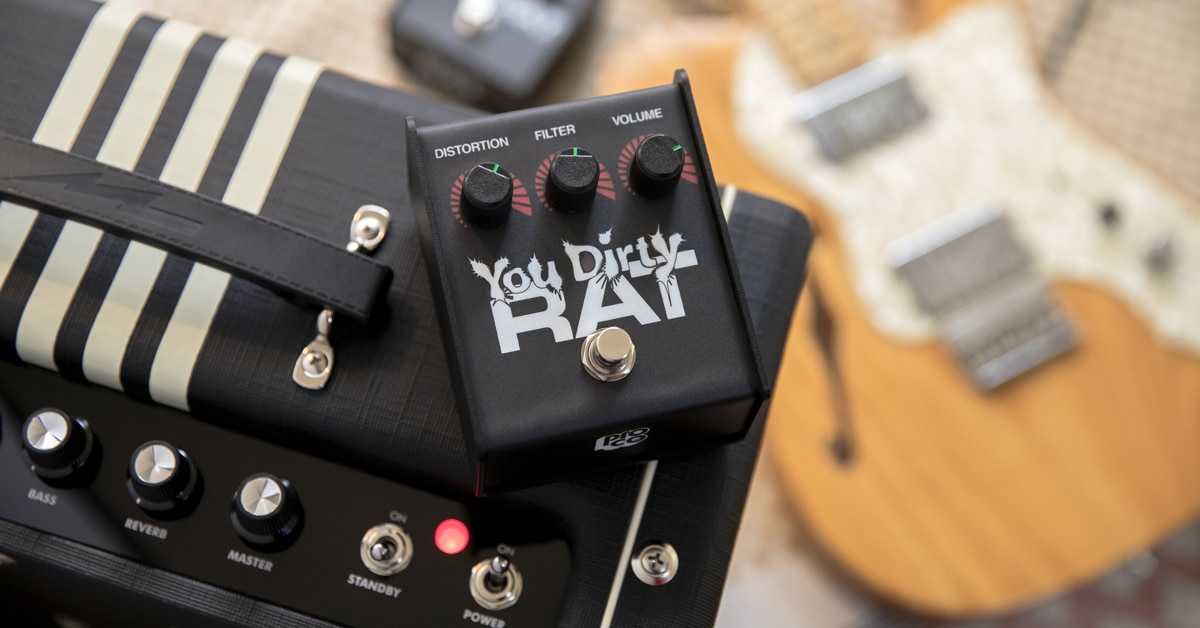Guitarists and bassists who want to extend what their instruments are capable of have a huge arsenal of effects pedals and processors they can turn to. From subtle to outrageous, guitar and bass effects pedals and multiprocessors help you capture inspiring sounds off recordings as well as spark your own creativity. Keep reading to get the details on the many types of guitar and bass effects you’ll find at Musician’s Friend. We’ll also get up close with some completely unique stompboxes.
Table of Contents
What Are Effects?
Where to Start
Analog vs. Digital Effects
Modeling
Overdrive and Distortion Effects
Pitch-Shift Effects
Modulation Effects
EQ Effects
Time-Based Effects - Delay, Reverb and Loopers
Sound-Conditioning Effects
Bass Guitar Effects
Effects Signal Chain Order
Multi-Effects Pedals and Processors
Pedalboards
Develop Your Signature Sound
What Are Effects?
Effects are electronic devices and circuits that process the electronic signal input from an instrument or mic. Also referred to as FX, they run the gamut from limiter or expander settings so subtle you can barely detect them to sci-fi modulation effects so extreme that the original sound is virtually undetectable. Think of your guitar or bass as your artist’s palette of primary colors. Effects are the equivalent of your brushes, tools, and color-mixing skills that add near-limitless creativity to your artistic vision.
The point of effects is to make your guitar or bass sound better in various musical contexts, create new and different sounds, or simply to have fun making strange noises. Many effects processors can give you hours of joy exploring their capabilities.
There’s been a steady evolution in effects signal processing since the 1940s. Guitarist-innovator Les Paul was among the first and most avid effects developers, experimenting with echo and multi-track recording to add sonic excitement to his music. The first foot-switched effect showed up in the late ‘40s with Harry DeArmond’s Trem Tol tremolo processor that was later used by Bo Diddley. In the 1950s and early 1960s other effects were developed, but they tended to be expensive and some had operational issues. Meanwhile amplifier makers such as Fender and Gibson were building reverb and tremolo effects into their amps. These tube amps also produced tasty distortion and overdrive effects when gain and volume were cranked up to maximum settings. Today, many effects are designed to reproduce those sounds.
With the advent of hard-rock acts like the Kinks and Yardbirds in the 1960s, the thirst for crunchy, distorted sounds grew insatiable. Kinks guitarist Dave Davies even slit his speaker cones in a quest for extra-gritty sound. The demand for loud, distorted output led to the rise of England’s Marshall amps, which were enthusiastically adopted by rockers on both sides of the Atlantic.
A half-century later, effects are everywhere. Whether they’re built into your amplifier, a single pedal, multi-effects processor, rack-mounted, or controlled through an iOS device, there’s a vast array of tones at your disposal, ready to add sonic magic to your performances or recordings. Most recording and performing guitarists have come to depend on effects to add flavors both subtle and flagrant to their sound, helping them to carve out the signature tones with which they’re identified.
Most often, you will see effect pedals housed in small metal boxes on the floor at a guitarist’s feet. They are often called stompboxes because stepping on a metal button turns them on and off. Many effects boxes also include a foot pedal allowing the player to modulate the effect’s intensity or volume. Sometimes you will see a larger floor unit with multiple buttons and pedals. These are called multi-effects pedals or processors. They usually have a wide variety of different effects that can be engaged simultaneously. Multi-effects processors have grown enormously in popularity as their sounds and functionality have improved.
Rack-mounted effects processors are another option, and are often used in pro and home studios as well as in stage rigs.. These effects units offer the same options as floor-based pedals and multi-effects units. They are simply mounted in a rack, and usually can be controlled with a foot pedal or the controls on their front panels. Newly developed iOS app-based and DAW-based effects add even more options to how you go about building an effects collection.
Where to Start
From beginners to seasoned professionals, most guitar players will experiment with effects at some point in their musical journey. While learning to play your instrument well should be a top priority, messing around with effects can be a fun way to engage with your instrument and start learning its sound possibilities without a lot of hard practice. There's a huge variety of stompboxes out there, many with very low price tags that make great gifts and can add a new dimension of fun for beginning players.
Many modern guitar amps also are equipped with multi-effects sections that encourage experimentation. There are also dozens of multi-effects pedals out there that are very affordably priced and offer a complete suite of effects. Most of these amp and effects processors feature presets created by engineers and pro guitarists to sound good at the touch of a button. Many allow you to create your own unique sounds then store them for instant recall. If you're a typical player, you'll adopt and abandon dozens of different effects boxes and presets over your playing career as your style and musical tastes evolve and change.
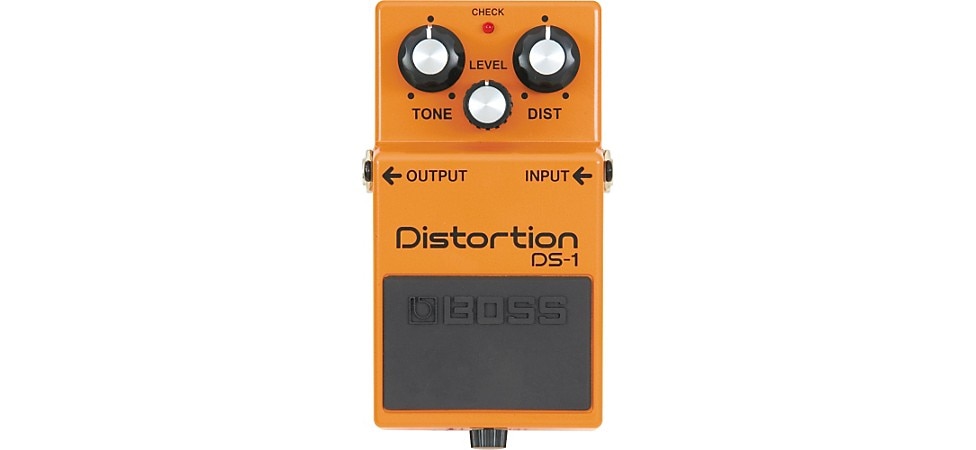
From subtle warmth to all-out crunch, the BOSS DS-1 serves up the precise helping of distortion you dial in.
With such a vast array of effects available, it can be hard to know where to start. One good way is to find out which effects your favorite players use. Artist interviews can be a great source of such information. Additionally, most players are happy to discuss their gear with fellow musicians. Talk to other guitar players you know, or chat up the guitarists or bassists at the local club before or after their sets.
If you’re ready to dive in, there’s a vast selection of affordable multi-effects pedals to choose from. Or if you’d prefer to try just one or two dedicated stompboxes, distortion and chorus pedals are a great place to start.
Musician's Friend also offers video and audio clips demonstrating many of the effects we sell. Just click on the Audio or Video tabs and links on product pages to get a better idea of what each effect can do and how well it will fit into your music.
Analog vs. Digital Effects
All the effects that were created up through the early 1980s were based on analog circuitry. That is, they operated by directly modifying an actual sound signal. Starting in the ‘80s, the digital revolution invaded the realm of guitar and bass effects with digital signal processing. Digital effects convert the instrument’s output to a digital bitstream that is then modified by digital circuitry before being translated back to analog sound signals for output. The first digital effects were all modeled on existing effects, but devices that followed such as pitch-shifting effects, delays, and harmony processors only became practical with the advent of digital signal manipulation.
While many players revere the original analog effects boxes and their modern reissues, the majority of effects on the market today have digital circuitry. Don't let that be a deterrent, digital effects are so advanced now that many of them can only be distinguished from analog effects by certified tone geeks. Professionals at all levels use digital effects. There are advantages to both analog and digital stomps, and either can be the right option depending on the player and the music.
Many music purists prefer analog effects. Since they don’t use digital conversion, the signal (purists argue) is less prone to loss, and is more pure as a result. It’s true that digital conversion can cause some natural artifacts of the original sound to become lost, and can sound more “processed.” However, as digital technology has evolved, this has become less of a consideration. Digital effects have the advantage of versatility and precision. Today’s multi-effects processors only exist because of digital processing; many effects can be achieved in a single unit through sheer processing power. Digital signals can also be used to control a wider range of parameters.
Modeling
Starting in the early '90s, music gear manufacturers began developing digital effects models that aimed to re-create the sounds generated by classic effects, instruments, and vintage amplifiers. This technology quickly expanded to include models of revered amplifier heads, speaker cabinets, microphones, and even specific microphone placements. Many amps and multi-effects units today incorporate a wide range of models, often grouped into categories such as stompboxes, amps, and mics. Over the last decade, Line 6, one of the leaders in this field, has even created guitars and basses that contain modeled sounds of famous vintage instruments. As the technology has grown more sophisticated, models have become more realistic, often very closely resembling the gear on which they’re based.
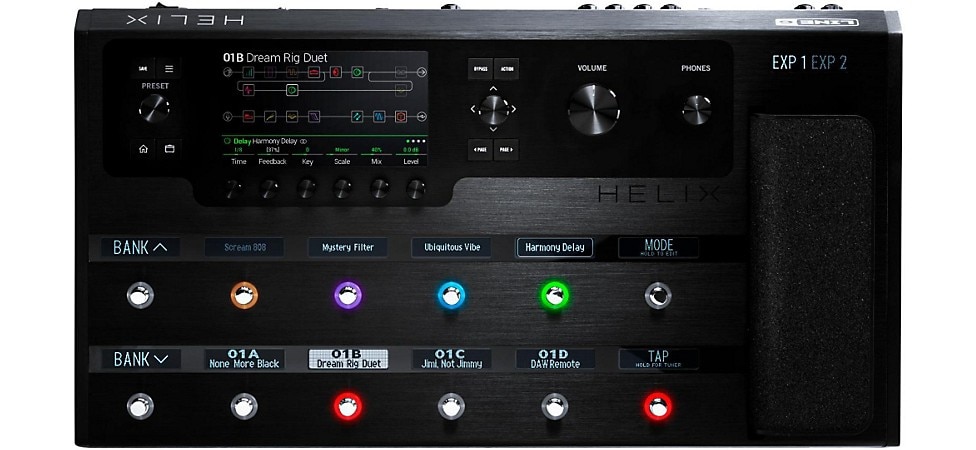
The Line 6 Helix offers players 86 amp models, 229 effect models and 41 cabinet models.
Presets
Whether or not they use modeling technology, most multi-effects units and many single-effect boxes provide you with presets. In a multi-effects processor or onboard an amp, these presets generally involve a complete setup with several effects applied and tweaked to create an overall sound. Usually presets are very easy to access.
Many modern processors have such great presets you'll never need to delve any further to create your own. However, almost all units with presets allow you to easily create your own favorite presets. You can start with a factory preset, tweak the sounds to your taste, then save it in your own location to be recalled at the touch of a button while you're playing.
Overdrive and Distortion Effects
Originally, distortion of the guitar signal happened accidentally when tube amps were turned up too loud. While distortion was first considered undesirable, players soon came to recognize that a distorted signal increased the amount of sustain they could get out of each note. This essential discovery created a fundamental shift in guitar soloing styles to include extended notes such as those produced by a wind instrument or organ. Used on rhythm guitar parts, distortion thickens up the signal and allows for a much heavier, chunkier sound.
Tube amp distortion is created when tubes are overdriven by receiving more juice than they can handle, thus causing the signal break up. Tube-driven amplifiers are still in demand by seasoned players because of the warm, musical tones they create, and some distortion-type effects use actual tubes to replicate that sound. But most distortion effects are produced either through analog solid-state circuitry or digitally.
Overdrive
Overdrive originally resulted from the natural breakup that occurred when a tube amp received an overly hot signal from a guitar. This pushed the tubes to deliver a subtle, warm breakup. Generally overdrive is a more subdued, natural form of distortion. While you don’t have to use an overdrive effect with a tube amp to get a great sound, the combination of the two can produce a rich, pleasing tone that many guitarists prefer. The first overdrive effects were designed to push more signal into a tube amp, giving it the very throaty, mid-range tone associated with Stevie Ray Vaughan. With that in mind, many of today's pedal makers have created circuitry to add that desired tone when used with a solid state amps as well. Since overdrive is a signal boost, adjustments from your volume knob will create a variety of different sounds.
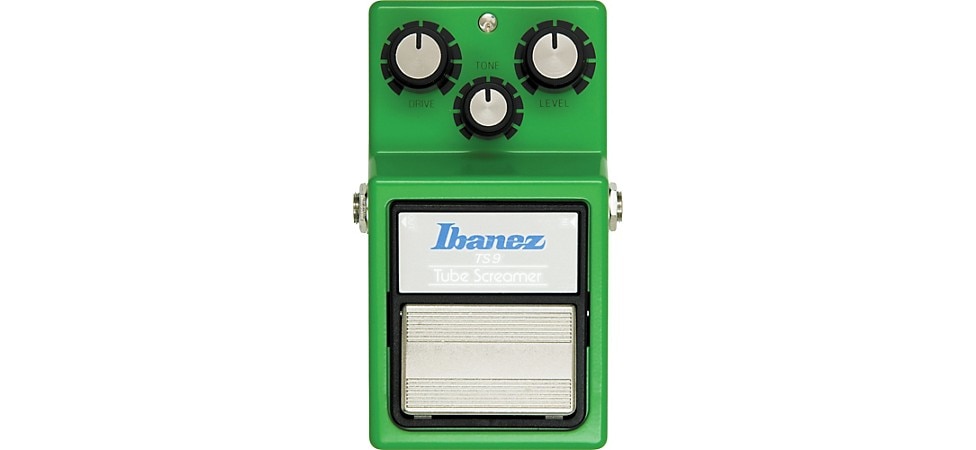
The Ibanez TS9 Tube Screamer pushes your amp from subtle to searing breakup.
Distortion
Due to distortion's critical function in modern guitar styles, by far the lion's share of stompboxes are distortion units of one kind or another. Most of these feature intensity and tone controls, but often vary wildly in terms of the sounds they create. You'll be amazed at the different types of distortions that can be produced, from rich, creamy, smooth, and melodic sustain to harsh, jagged, and piercing breakup tones. Many distortion units produce a broad range of textures.
Often the names and appearances of these pedals will give you a clue as to what types of sounds they produce. Otherwise it's a good idea to look at interviews and endorsements to learn which distortion stompboxes your guitar heroes are using. Also, be sure to check out our videos and audio clips to get a sense of each distortion pedal’s capabilities.
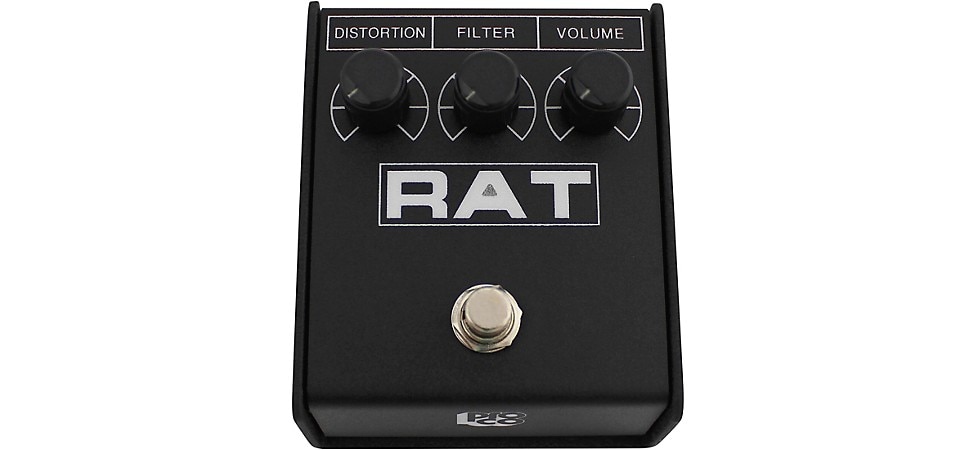
While classified as a distortion pedal, the Pro Co RAT2 delivers a wide range of sounds, from blistering overdrive to ferocious fuzz.
Fuzz
A fuzz pedal is essentially an extreme distortion effect. Because fuzz so radically alters the signal, it is often used sparingly for contrast, rather than as a meat-and-potatoes sound. Since it thickens up the tone so dramatically, fuzz can be fun for intros and solo guitar parts when no other instruments are playing. Originally coming into prominence in the 1960s, the three most famous fuzz pedals are the Tone Bender, Fuzz Face and Big Muff.
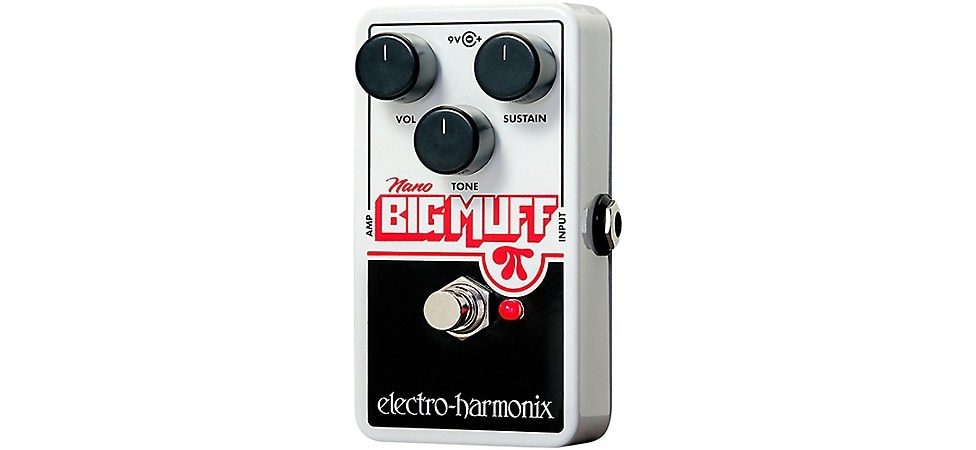
Electro-Harmonix's Nano Big Muff gives you classic Big Muff tone in a much smaller package
Boosters
Unlike fuzz and distortion pedals, booster effects typically are engineered to boost the signal reaching the amp without adding coloration. Some booster pedals do slightly fatten the tone of the guitar by overdriving the preamp stage of the amplifier. They can be very useful in getting your amp to break up and produce musical-sounding distortion at lower volume levels as well as adding clarity to your solo riffs. A booster pedal can become an essential part of your rig when you have more than four effects in your signal chain or 18 feet or more of cabling between your instrument and amp.
Some booster pedals add a buffering circuit that helps restore your instrument’s original output level and treble range when it’s has been reduced by your cable length and effects chain. Some boosts also include basic EQ for further tone sculpting.
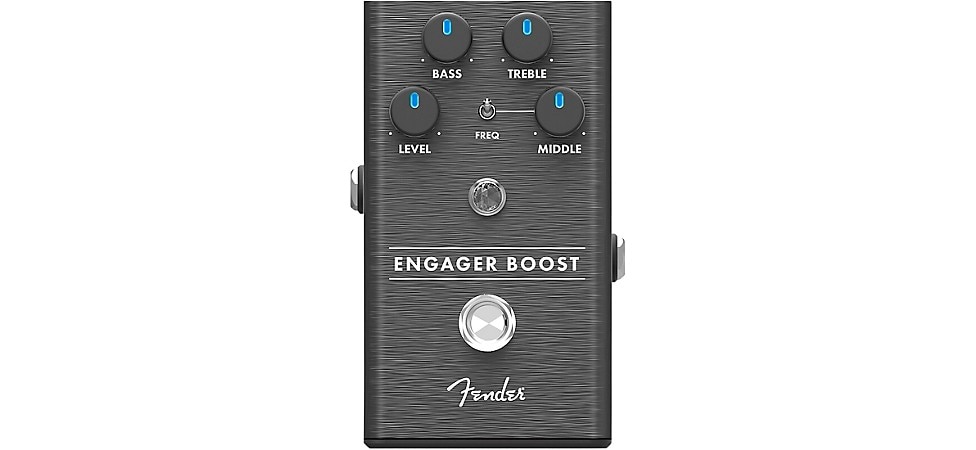
Fender's Engager Boost offers up to 20dB of boost to help you cut through the mix.
Pitch-Shift Effects
Pitch shift effects, which includes harmony and octave pedals, are a lot of fun, and add depth and flavor to a guitar player’s sound. The effect works by taking the fundamental note being played on the guitar, and adding another note either above or below the original. Simply adding more notes will often produce odd, off-key notes if you’re not careful. Most modern pitch-shifting effects use advanced technology to make sure the added notes work harmoniously with the original.
Harmony Effects
Harmony pedals are often used to generate vocal harmonies, but can also do wonders for bass and guitar sounds. Some vocal harmony processors use the signal from your guitar to create two- or three-part vocal harmonies. Most harmony effects let you specify precisely how much higher or lower you want the accompanying note to be. Modern artists such as Steve Vai and Robert Fripp have created interesting music using a purely pitch-shifted signal with none of the original signal mixed in.
Many modern harmony effects simplify the setup by allowing you to specify the key you're playing in and the interval to the harmony notes. Many also allow you to mix two or more harmonies simultaneously. Used judiciously, harmony processors and pedals can dramatically fatten up your sound.
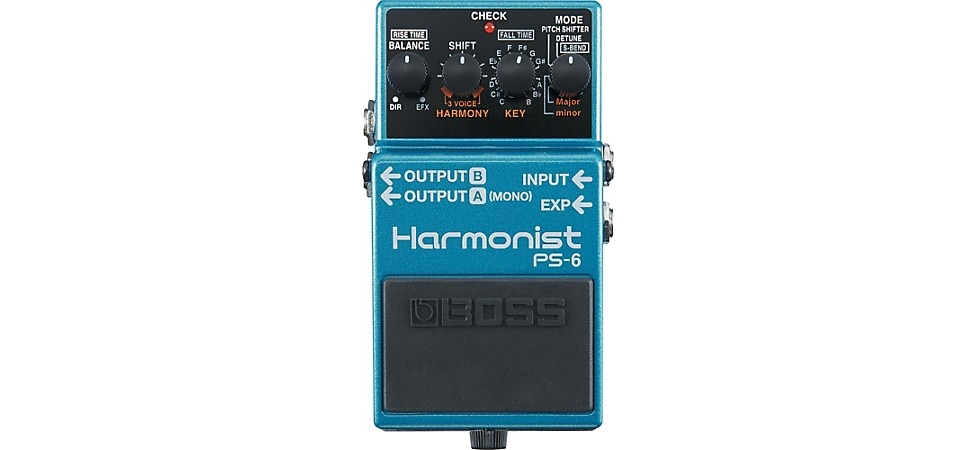
The BOSS PS-6 Harmonist makes it super easy to create 3-voice harmonies from your lead playing.
Octave Generator
An octave generator is a simplified form of pitch shifting. This effect will allow you to add an octave—usually below—the fundamental note. Units that add a lower octave exclusively are referred to as sub-octave generators. They can add a lot of depth to the guitarist’s sound. Many bass players also use sub-octave generators to significantly fatten up their sound.
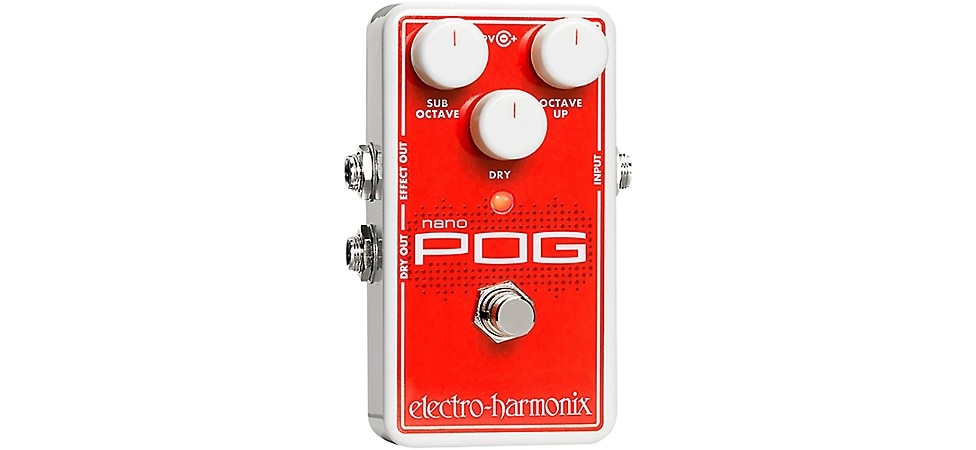
The Electro-Harmonix Nano POG is a polyphonic octave generator that lets you blend your dry signal with an octave up and a sub-octave.
The Whammy
The Whammy pedal is truly one-of-a-kind. It gets its name from the slang term for a tremolo arm on a guitar, which allows a player to control the pitch of the strings while playing. In much the same way, The Whammy pedal allows a player to perform radical pitch-shifting in real time by rocking the foot treadle back and forth, sweeping between the intervals set on the pedal. This pedal is a lot of fun and allows guitarists to create the dive-bomb sounds that are associated with JImi Hendrix, Eddie Van Halen, and Joe Satriani.
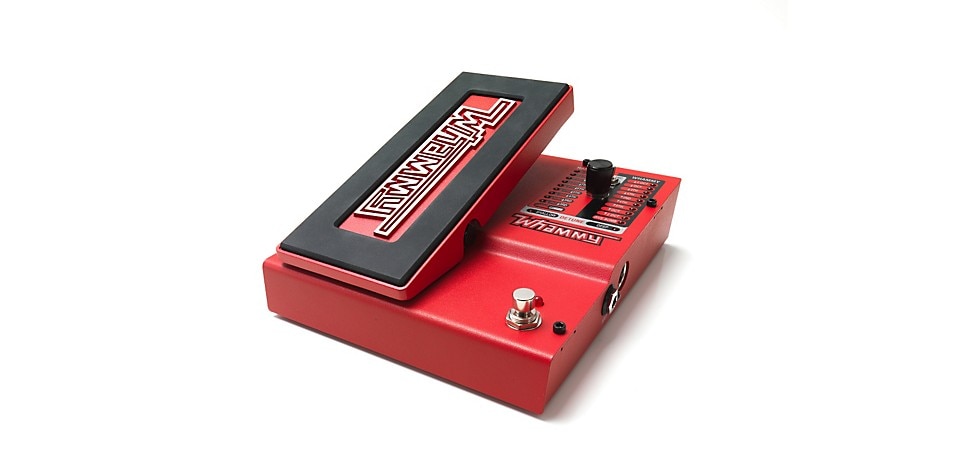
Digitech's iconic Whammy pedal gives you total control of your pitch from quick dive bombs to rubbery pitch bends.
Modulation Effects
Modulation effects duplicate the waveform of the fundamental signal and alter it, then blend the altered signal and the original signal to create the effected sound. This may sound complicated, but whether you realize it or not, many of your favorite guitar sounds probably use a modulation effect in some way.
Tremolo
A tremolo effect simply alters the volume of a signal at a preset interval, within a preset range. Some amps have this effect built-in, and in some cases it’s called vibrato (a misnomer that caught on long ago and has stuck around to this day). Tremolo sounds much like hitting a note and then turning your volume knob up and down rapidly. Most tremolo effects have two controls: speed and depth. Adjusting speed changes how rapidly your volume fluctuates. Adjusting the depth controls the range of volume from loud to soft as the tremolo fluctuates.
Tremolo can be a subtle effect, as heard in “Born on the Bayou” by Creedence Clearwater Revival and "Gimme Shelter" by The Rolling Stones, or more distinct as heard in “Crimson and Clover” by Tommy James and the Shondells and “Bones” by Radiohead. Tremolo has been around since the earliest days of the rock era, and was popular with rockabilly and surf guitarists.
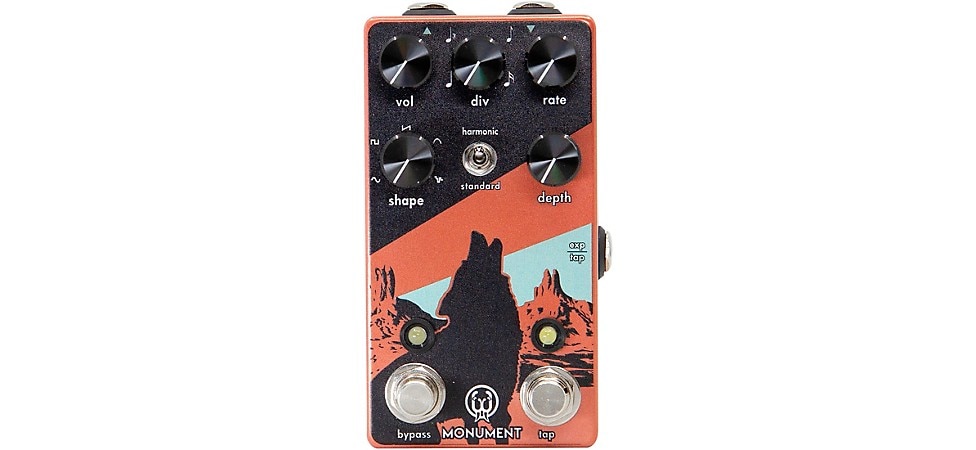
Walrus Audio's Monument Harmonic Tap Tremolo recreates the classic sound of warm, pulsating tremolo found on amps of the 1960s.
Phaser
Phasers, also called phase shifters, duplicate the original waveform of a guitar’s output, and shift one wave out of phase with the other. They blend both waves together usually applying an oscillating circuit, resulting in the waves moving in and out of phase with each other creating spacey, “whooshing” effects. “Itchycoo Park” by the Small Faces was an early example of phase shifting in a recording. Eddie Van Halen and Queen’s Brian May often used phase effects in the 1970s and ‘80s.
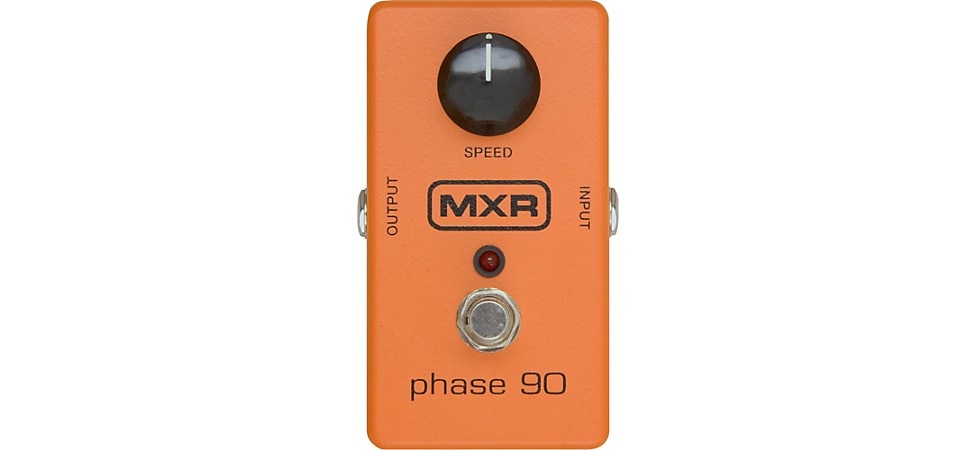
Using the MXR Phase 90 you can add everything from subtle shimmer to jet-plane whooshing sounds.
Flanger
Flanger effects simulate the studio trick of repeatedly putting your thumb on a tape recorder’s reel for a second and then letting the reel (and music’s pitch) catch back up while a dry (unaffected) signal plays alongside. Flangers usually have a depth setting, which controls the intensity of the effect, and a rate control that adjusts the speed of the cycles.
Flanging can be a subtle effect, thickening the sound and imparting a spacey feeling. Or it can be extremely dramatic when cranked up, to the point of making the original signal unrecognizable. This broad range makes a flanger a fun stomp box to experiment with. Jimmy Page used a flanger to good effect on Led Zeppelin’s “Nobody’s Fault But Mine” and “Kashmir, ” as did Jimi Hendrix on “Bold as Love.”
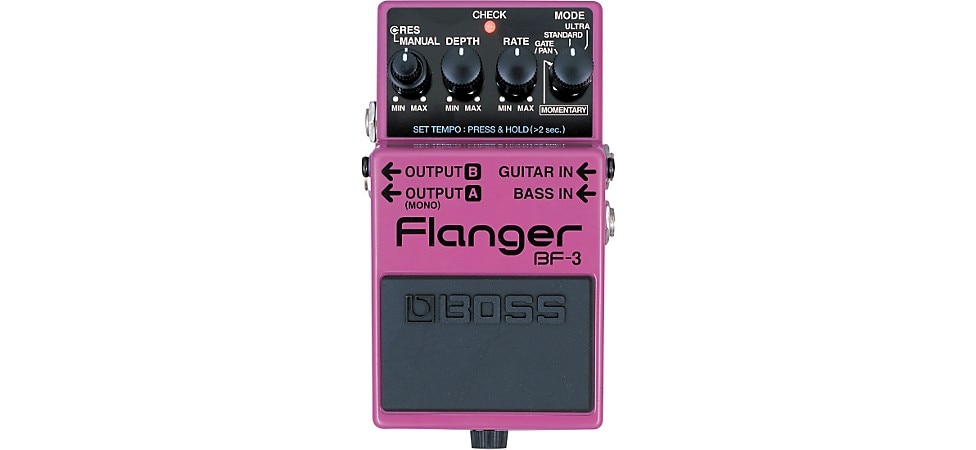
The BOSS BF-3 brings stereo psychedelia to your pedalboard.
Chorus
A chorus effect alters the duplicated waveform in a more subtle, nuanced way. The altered waveform will sound much like the original, but just different enough to sound like multiple voices playing the same note or notes. As it is usually applied, chorus sounds like the same signal running through two amps with a very slight delay between them. In fact, Pat Metheny's famous chorus sound is produced in exactly this manner, using no actual chorus effect at all.
Chorus is a great way to thicken up the sound of a bass (especially in a 3-piece band), rhythm guitar, or solo guitar. It is often used with distorted sounds but is a fantastic way to create full-sounding clean sounds as well. Stereo output (from two separate speakers) enhances chorus a great deal. Many acoustic guitar amps include a clean-sounding chorus effect adding depth and character to the amplified signal. Chorus pedals can be very helpful in fattening up the tone of acoustic-electric guitars whose piezo pickups tend to sound a little thin.
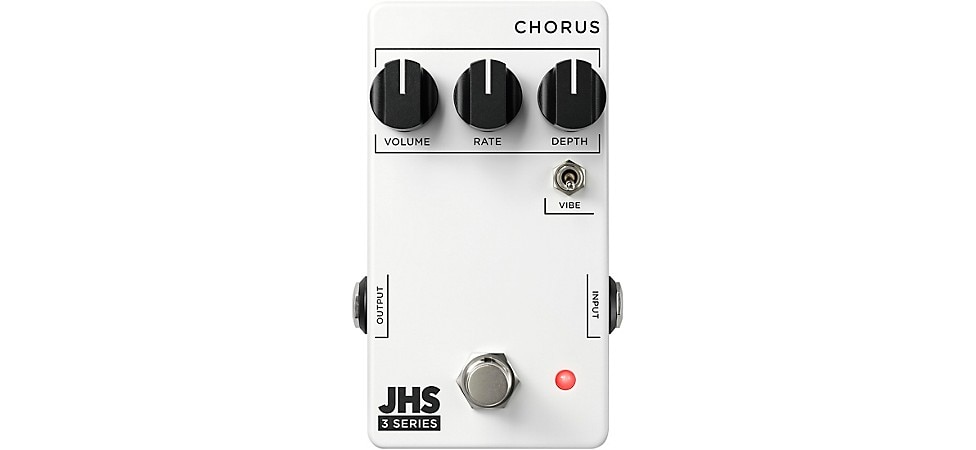
The JHS 3-Series Chorus offers classic chorus and vibrato sounds with a straight-forward three knob setup.
Time-Based Effects - Delay, Reverb and Looping
By and large, time-based effects split the guitar output into two identical signals and momentarily hold one back while allowing the other to play in real time. The two signals are mixed back into one at the output. Usually you can control the length of the delay and the amount of the signal that is affected versus the part that stays "dry" (unaffected). This latter control—found on most effects—is usually called the level control.
Delay
One of the earliest studio effects created by taking advantage the distance between the record and playback heads on tape recorders, delay duplicates the original signal and repeats it after the original sound is played. This can be repeated over and over for an echo effect, or be a single repeat that produces the slap-back sound popular in rockabilly. The time between repetitions can be very short, measured in milliseconds. Or it can be longer and more dramatic. Delays can also add a rhythmic element to your playing. There are many different kinds of delay effects available, and most offer a number of different types in the same unit.

Warm-sounding all-analog circuitry makes the MXR Carbon Copy Analog Delay a perennial best-seller.
Reverb
Reverb is a more subtle form of delay that replicates the natural echo effect of various spaces, such as small, medium, or large rooms or concert halls. Many amplifiers have built-in reverb effects, but a lot of guitar players like having a separate reverb pedal for an increased range of programmable options. Some modern reverb stompboxes emulate the sound of vintage reverb devices that used reverberating springs or plates to achieve their effects. Reverb is great tool to add color to a very clean tone, but can quickly make a heavily distorted tone sound muddy.
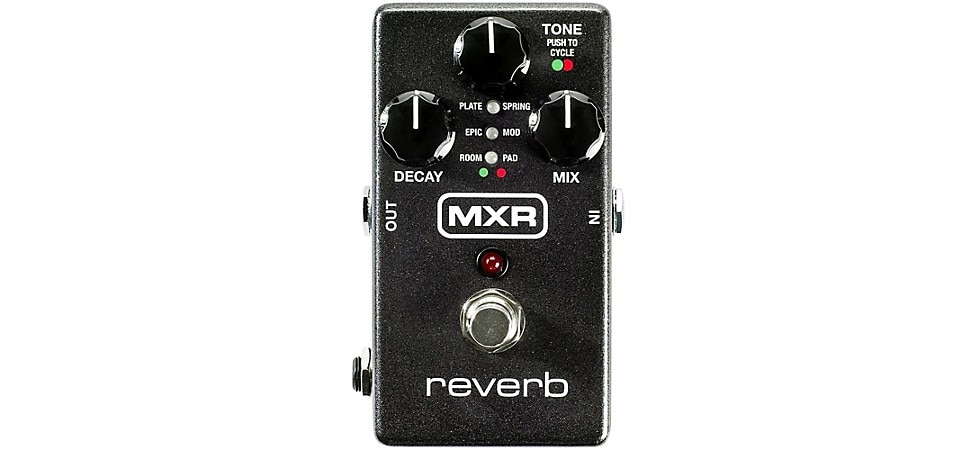
MXR's M300 Reverb is packed with six different types of reverb.
Looping
A looper allows you to record a musical passage or phrase then play that passage back repeatedly. You can then record more loops and layer them, one on top of the other. Most recording and playback functions are foot controlled, and once you’ve created suitable backing tracks, you can can then play over the repeated passages in real time, creating exciting one-man-band sounds never possible before. Many of the more advanced models include built-in rhythms, custom effects, inputs for vocal mics and other instruments, plus MIDI and USB capabilities so that you can use the looper as part of your digital song-creation and recording processes.
While a good looper provides phenomenal musical potential, especially for solo performance, and most are simple to use, looping can be challenging for the novice to master. Experienced musicians will have an easier time creating with them, either in realtime performance or songwriting.
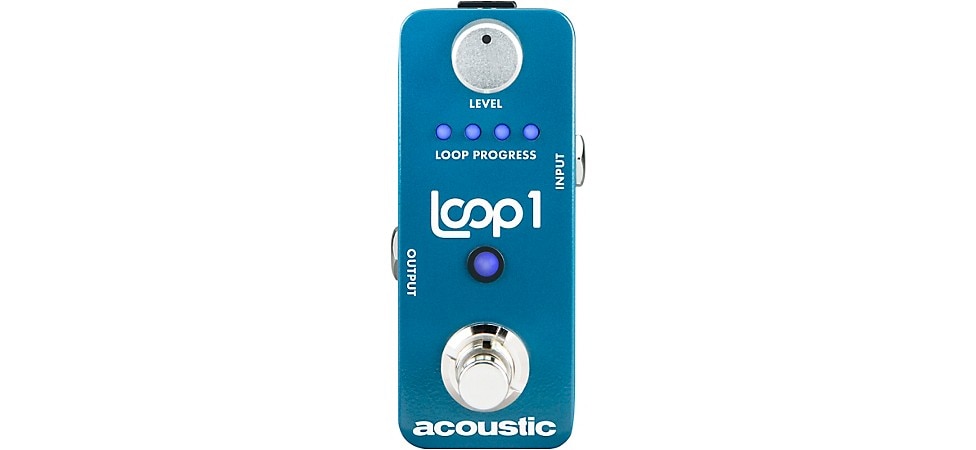
The Acoustic Loop1 Looper offers 30 minutes of looping time with unlimited overdubs for endless performance possibilities.
EQ Effects
EQ or equalization effects work by boosting or cutting specified frequency bands within the sound signal. From treble or high-end sounds such as the sizzling sounds of a riveted cymbal to low-end sources such as the thump of a bass drum or bass guitar, EQ effects don't change the pitch but rather alter the timbre or quality of the sound. Depending on the application, EQ control can be quite precise or very simple.
Most guitars and basses have one or more tone knobs, which offer a simple form of EQ control. Using these tone knobs adds or cuts the treble frequencies of the instrument’s signal. Most guitar and bass amps also have some tone control available, usually in the form of a 3-band EQ section, allowing you to control bass, mid, and treble frequencies with independent knobs. These knobs boost or cut frequencies when you turn them up or down. Some amps and effects offer more precise control of equalization as we’ll see next.
Refining the Sound
For more control and fine tuning of your sound, you may want to use a parametric or graphic EQ. A parametric EQ allows you to adjust the width of the frequency band that's being altered and the shape of the curve—how abruptly the boosted or cut area changes to the unmodified area. A graphic EQ divides the frequency ranges into a number of narrow bands which can each be boosted or lowered by sliders, thus giving you a visual or "graphic" representation of how the EQ is being affected. The more bands there are, the more precise your adjustments can be.
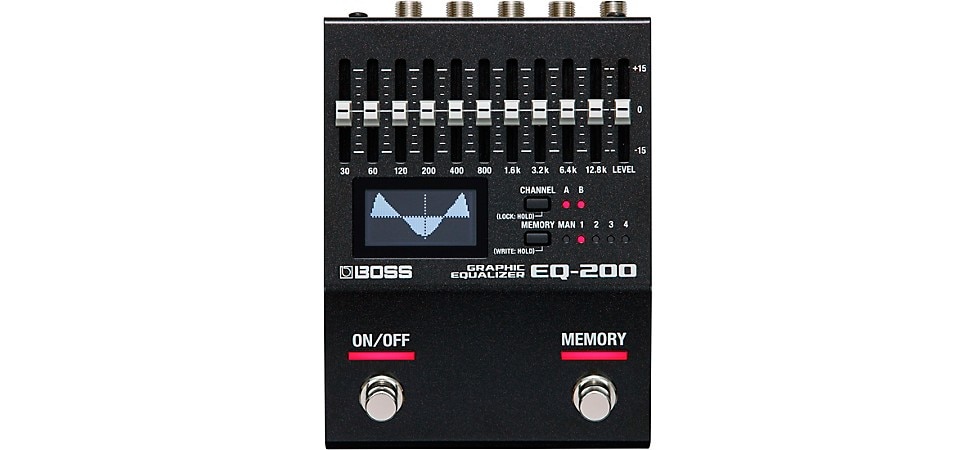
The BOSS EQ-200 offers up to 15dB of boost or cut across each of its 10 bands.
EQ can make a tremendous difference in the sound of your instrument. This becomes especially important when playing in a band setting. Your guitar might sound great played alone, but within the sound mix of a full band may need some tweaking. Depending on which instruments are involved, you will need to adjust EQ to help your guitar fit into the overall sound the rest of the band. Using an EQ effects processor can help you dial that sound in more easily and precisely than depending on just your guitar and amp’s EQ controls.
The Wah Pedal
One other effect that depends on EQ modulation is the wah pedal. As you rock forward on the pedal, the sound becomes more trebly. As you rock back, the treble range is muted. In the middle positions, a wah produces a nasal, midrange-heavy tone that is interesting and useful in its own right. Since you can change the wah's tone constantly while you're playing, it's a very dynamic and expressive effect that can become an integral part of your playing. Jimi Hendrix was one of the first guitarists to exploit the wah’s capabilities.
There are a broad range of wah-wah pedals available, each with its own distinctive flavor. Among the two most popular wahs are VOX's V847a and Dunlop's Crybaby.
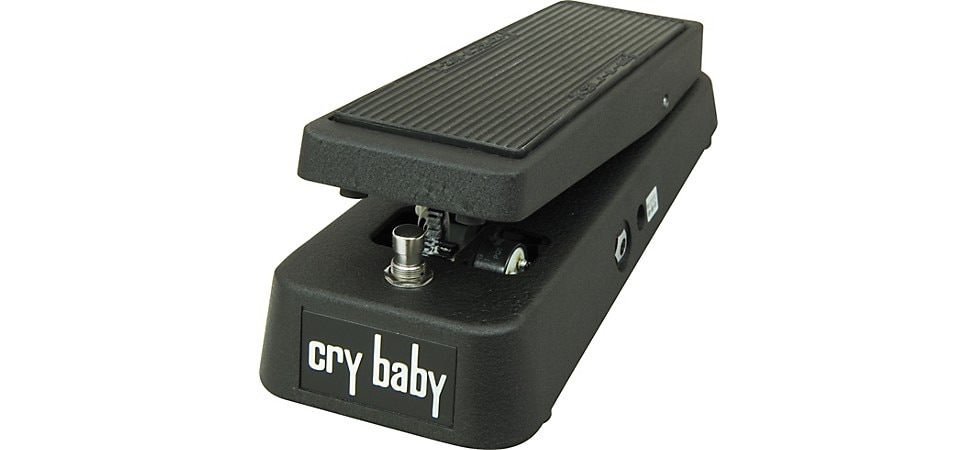
Dunlop’s Original Cry Baby produces the wah effects you’ve heard on countless records.
A variation of the wah pedal is the auto wah. Not to be confused with a city in Canada, auto-wah effects do the same things a wah does, but without the foot treadle. Usually, you can adjust the attack time (how fast the tone shifts toward the treble) and the depth of the cycle. Some auto-wahs also let you set a constant up and down motion that's not triggered by the note. You’ll find auto-wahs included in many multi-effects processors.
Sound-Conditioning Effects
While most effects pedals can drastically alter your sound, there are some that add more subtle elements to your signal to create a more pleasing sound. They may not be as exciting or fun to play with, but they can be the difference between pretty good and truly great sounds. As your collection of effects grows and opportunities to play with bands increase, some of these will become important additions to your rig.
Volume Pedal
A volume pedal does the same thing a volume knob on a guitar, but it allows you to control the volume with your foot. It is not a boost, it just allows you to sweep between zero output and the full output capacity of your instrument. Many guitarists use a volume pedal, also sometimes referred to as an expression pedal, to create pedal steel-like swells, where a note or chord is played, then the volume is slowly and smoothly raised. Volume pedals can also be used as a boost effect, by simply playing at less than full volume, then stepping on the pedal to go to full volume momentarily when you need the extra boost. Volume pedals can make a standard electric guitar sound like a pedal steel when used with a well-practiced foot technique.They can also be an important pedal to have in your toolbox when playing in a band with multiple guitars.
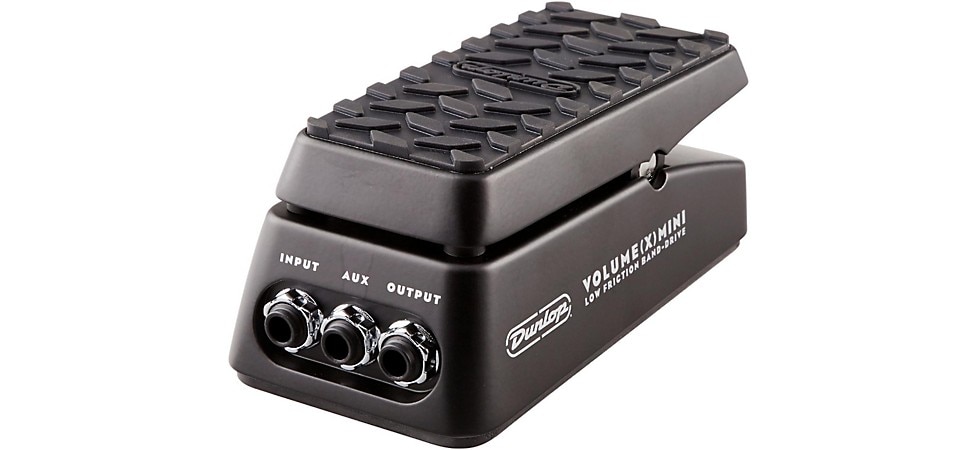
The Dunlop DVP4 Mini Volume Pedal gives you total control of your sound, without taking up a lot of space on your board.
Compressors
A compressor affects the dynamics of your guitar or bass signal. By making very quiet signals louder and loud signals quieter, it "compresses" the dynamic range of the signal. This can be very helpful for keeping your quieter passages from getting lost in the rest of the music, and your louder passages from drowning everything else out.
Compressor pedals add a softening effect too, by reducing the front edge of notes and amplifying their tails. This increases sustain by bumping up the signal as the note fades out. Most compressors allow you to control both the thresholds (upper and lower limits) and the knee (the speed with which the signal is raised or lowered). The big appeal for guitarists is the compressor's ability to simulate the natural compression that tube amps generate when driven at medium to high levels. A good compressor can help thicken up the sound of your guitar and add extra punch to your performance.
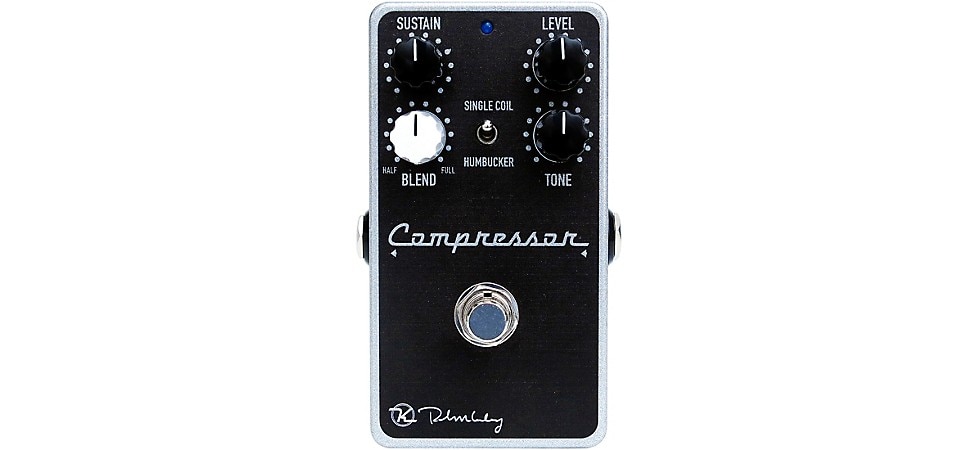
The Keeley Electronics Compresser Plus not only compresses your signal but adds gain as your notes fade out, increasing your overall sustain.
Noise Gates
A noise gate is a very handy device that gets rid of hums and hisses that may become apparent when you're plugged in but not playing your instrument. Basically a limiter in reverse, the noise gate simply cuts out sounds below a preset level. As long as you're making music your sound is full on; but as soon as you stop playing, all the noise generated by your effects chain, vintage amp, and/or house wiring is silenced.
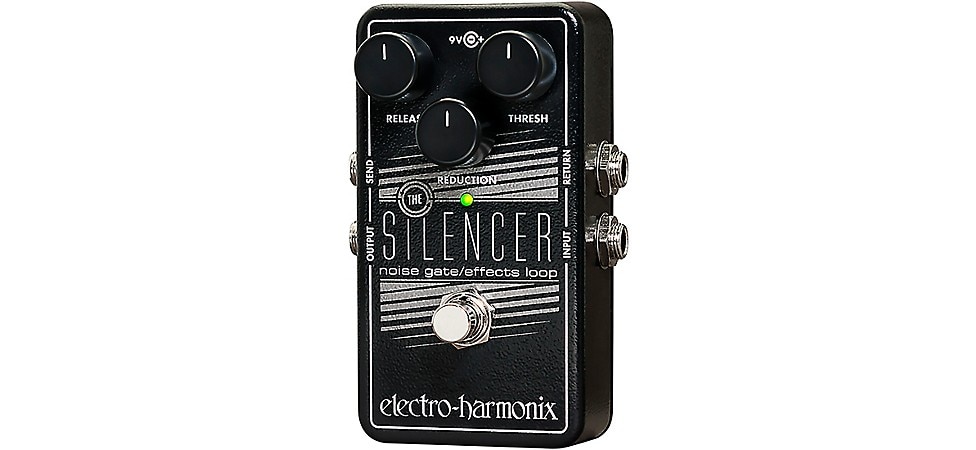
The Electro-Harmonix Silencer eliminates noise and hum during those quiet moments.
Bass Guitar Effects
As with guitarists, bass players have a vast selection of effects to choose from. They’re designed specifically to take into account bass dynamics and the challenges that face bassists in crafting a signature sound and sonically meshing with the rest of the band.
You’ll find a full slate of dedicated bass stompbox effects as well as many multi-effects pedals and processors. Like their guitar-friendly cousins, bass effects offer most of the same tone shaping capabilities, including chorus, reverbs, delays, phasers, and tremolos. Because of the bass’s unique sound dynamics that reach deep into the lower frequencies, many bass effects are focused around compression and limiters that help keep a lid on destructive subsonic sound waves that can damage gear. Typically, many guitar effects are not optimal when used with a bass.
The Effects Signal Chain Order
Your signal chain starts at your guitar and passes through each cable and pedal until it reaches your amplifier, the speakers, and finally your ears. If you use a collection of dedicated effects stompboxes, you will be faced with a perennial question raised by guitarists: what is the best way to connect these units into a single signal chain that is easy to set up and won’t degrade your tone.
There is some generally accepted wisdom regarding the proper order for multiple effects in your signal chain. This is because as a signal is modified from one effect to the next, it can change the way each subsequent effect processes the signal, and ultimately how your overall tone sounds.
Multi-Effects Pedals and Processors
Multi-effects units are exactly what the name implies—single units that offer many different effects and allow those effects to be used singly or in combinations simultaneously. Most will offer just about all the effect types discussed in this guide and many more. Typically they include dozens if not hundreds of effects presets—combinations of effects and effect parameters designed to achieve specific sounds with the touch of button or footswitch. Most also allow you to also save your presets for instant recall.
Multi-effects pedals and processors come in three basic formats: floor-based units equipped with foot-operated pedals and switches, tabletop units with knobs and switches, and rack-mounted units. Most tabletop and rack-mount units offer foot control options in addition to the knobs, switches, and menus accessible from their control panels. Pedals and footswitches are often user-assignable so that you can instantly engage various effects settings and other presets with a single toe tap.
Often, multi-effects pedals and processors can be more cost-effective than purchasing multiple stompboxes. They also avoid the potential noise and tone-degrading impact of chaining numerous individual pedals together. That said, many guitarists prefer the way certain dedicated pedals sound or operate, and will collect many single-effect stompboxes along the way. If you are looking at purchasing multiple effect units but don’t have any favorites, purchasing a multi-effects processor can be a money-saving alternative.

The Headrush Gigboard is loaded with authentic amp and effect models and is the perfect choice to simplify your live rig.
Advanced multi-effects processors can involve significant learning curves. Their hundreds of sounds and functions may entail diving deep into multi-layered menus to get at what you want. The best units offer intuitive and ergonomic user interfaces that keep the most common functions easily accessible via dedicated knobs and switches. Reading user and pro reviews can help you identify which models offer the greatest ease of use.
Pedal Boards
Residing between your guitar and your amp, your effects pedals make it possible to change up your sound between songs or even verses. A pedalboard makes it easier to manage and transport all those stompboxes. The longer your effects chain, the more helpful a pedalboard becomes. Keeping all your pedals in one place, a pedalboard helps you stay organized and keeps your effects layout consistent.
Many pedalboards on the market are powered. They feed DC power directly from the board to your pedals, eliminating the need for battery changes or external power adapters. This simplifies your setup and minimizes your need for power outlets. Some pedalboards even have a small built-in combo amplifier, making them a great practice and jamming solution.
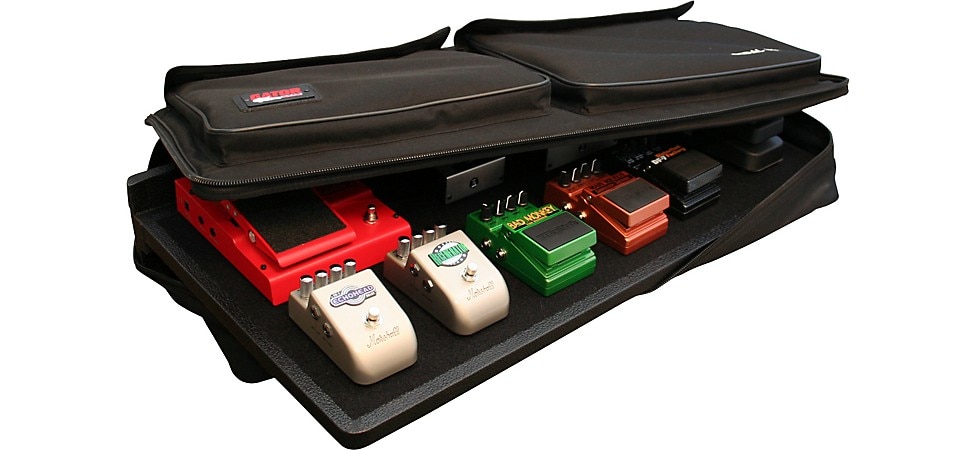
With its 16” x 30” pedal mounting surface and integrated carrying bag, the Gator GPT-PRO is the tone tweaker’s solution to going mobile.
For the guitarist who's frequently on the road or often plays out, the pedalboard is an indispensable aid. Many pedalboards include custom-fitted travel cases or gig bags. With your effects already mounted on the pedalboard, performance setups are fast: just unpack the already-configured board, plug in your guitar and amplifier, and you're ready to play.
Develop Your Signature Sound
Many artists have defined their signature sound by discovering effects to set them apart from the crowd. By experimenting with effects, you too can begin to achieve the sound you’re looking for. Along the way, you’ll find stompboxes and effects multi-effects processors offer endless enjoyment through testing, refining, and experimentation.
We want you to be pleased with your guitar or bass effects purchase, and offer a generous return policy so you can order with confidence.





































































































































